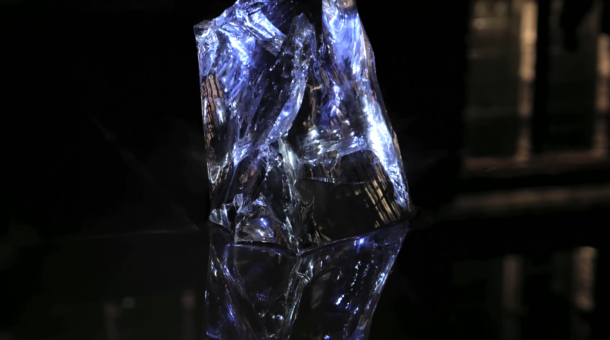In Antarctica, researchers brave the blistering cold to drill hundreds of metres into the ice to retrieve cores.
Ice cores are made up of snow that fell hundreds of thousands of years ago and preserves an archive of past climate changes. Changes in snow fall and temperature can be determined from these cores but most importantly, the composition of our atmosphere is captured within tiny air bubbles in the ice. The air trapped within these bubbles can be analysed to reveal the concentration of greenhouse gases, including carbon dioxide and methane.
The oldest ice core dates back 740,000 years and was retrieved during the EPICA project – a collaborative effort between 10 European countries.
The information contained within ice cores provides evidence of how carbon dioxide levels affected our climate in the past. However, carbon dioxide levels are now significantly higher than those found in even the oldest ice cores. Human activity, burning fossil fuels and deforestation has caused this increase, and has led to unprecedented changes in our climate over the past century.

Shallow ice core being taken at a site south of Halley Research Station on the Antarctic Plateau at approximately 80 degrees south: analysis of the ice reveals the increase in heavy-metal pollution during the 20th century.

International European Project for Ice Coring in Antarctica (EPICA) project: Dronning Maud Land reconnaissance phase. Scientists remove a core from the barrel of an ice core drill: analysis of the ice, which fell as snow more than 1000 years ago, will reveal changes in climate and the composition of the atmosphere.

RRS Bransfield at ‘Bunny’s iceport’ on the Brunt Ice Shelf loading waste and outbound cargo from Halley research station. RRS Bransfield left BAS service in 1998 when replaced by RRS Ernest Shackleton.

Formvar replica taken on the Avery Plateau during December 1995. Small snow crystals around 1mm across. They are classified as dendrites.

Formvar replica taken on the Avery Plateau during December 1995. Cloud particles about 50-500 microns across. They are mostly hexagonal plates.

Ice core drilling at a Berkner Island drilling site. Scientists have succeeded in drilling 1000 metre-deep ice core and reached bedrock. The core gives a continuous record of the climate on Berkner spanning the past 30,000 years. This period is particularly interesting as it includes the dramatic tranition from the last ice age into the current Holocene warm period, when the average temperature of the Antarctic rose by 8C. Situated at the southern end of the Atlantic Ocean, the Berkner Island coast will give a clear view of the southern response to changes in ocean currents that are believed to have occurred during this period. This image is associated with the 2005-2010 BAS science programme: CACHE- Climate and Chemistry: Forcings, Feedbacks and Phasings in the Earth System.


Dielectrical profiling experiment on an ice core retrieved at Berkner Island. Scientists have succeeded in drilling 1000 metre-deep ice core and reached bedrock. The core gives a continuous record of the climate on Berkner spanning the past 30,000 years. This period is particularly interesting as it includes the dramatic tranition from the last ice age into the current Holocene warm period, when the average temperature of the Antarctic rose by 8C. Situated at the southern end of the Atlantic Ocean, the Berkner Island coast will give a clear view of the southern response to changes in ocean currents that are believed to have occurred during this period. This image is associated with the 2005-2010 BAS science programme: CACHE- Climate and Chemistry: Forcings, Feedbacks and Phasings in the Earth System.

Ice core drilling at a Berkner Island drilling site. Scientists have succeeded in drilling 1000 metre-deep ice core and reached bedrock. The core gives a continuous record of the climate on Berkner spanning the past 30,000 years. This period is particularly interesting as it includes the dramatic tranition from the last ice age into the current Holocene warm period, when the average temperature of the Antarctic rose by 8C. Situated at the southern end of the Atlantic Ocean, the Berkner Island coast will give a clear view of the southern response to changes in ocean currents that are believed to have occurred during this period. This image is associated with the 2005-2010 BAS science programme: CACHE- Climate and Chemistry: Forcings, Feedbacks and Phasings in the Earth System.

A close up of a slice of ice core. The clearly visible trapped air bubbles form an archive of past atmosphere and temperature.

A dramatic grounded iceberg seen from Lagoon Island in Ryder Bay, Antarctica.

Ice core slice showing the bubbles of trapped air. This piece is from the EPICA ice core.
Reference:
https://www.bas.ac.uk/data/our-data/publication/ice-cores-and-climate-change/
Notes:
Formvar is a thermoplastic resin used to create replicas of ice core slices and snow crystals.
Berkner Island is the largest Antarctic Island and has ideal topography for ice core drilling.





